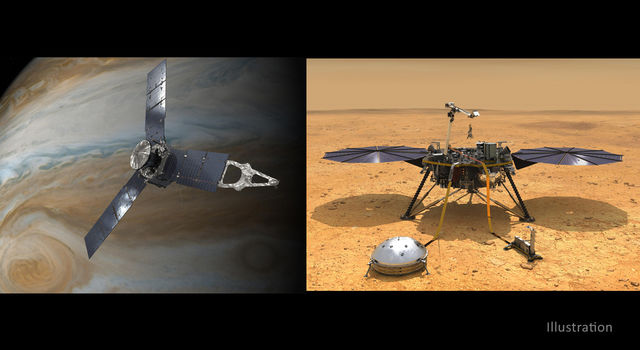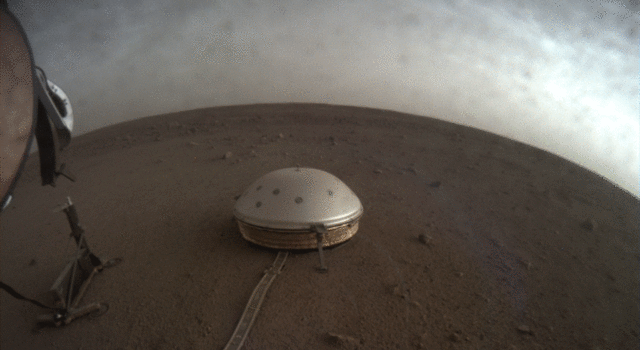Blogs | Dawn Journal | April 30, 2012
Dawn Ascends Over Asteroid Vesta
Dear Dawnright Spectacular Readers,
Dawn is wrapping up a spectacularly rewarding phase of its mission of exploration. Since descending to its low-altitude mapping orbit (LAMO) in December, the stalwart probe has circled Vesta about 800 times and collected a truly outstanding trove of precious observations of the protoplanet. Having far exceeded the plans, expectations, and even hopes for what it would accomplish when LAMO began, the ambitious explorer is now ready to begin its ascent. On May 1, atop its familiar blue-green pillar of xenon ions, the craft will embark upon the six-week spiral to its second high-altitude mapping orbit.
When the intricate plans for Dawn's one-year orbital residence at Vesta were developed, LAMO was to be 70 days, longer than any other phase. Because of the many daunting challenges of exploring an uncharted, alien world in the forbidding depths of the asteroid belt so far from home, mission planners could not be confident of staying on a rigid schedule, and yet they wanted to make the most of the precious time at the giant asteroid. They set aside 40 days (with no committed activities) to use as needed in overcoming problems during the unique approach and entry into orbit as well as the intensive observation campaigns in survey orbit and the first high-altitude mapping orbit plus the complex spiral flights from each science orbit to the next. To no one's surprise, unexpected problems did indeed arise on occasion, and yet in every case, the dedicated professionalism and expertise of the team (occasionally augmented with cortisol, caffeine, and carbohydrates) allowed the expedition to remain on track without needing to draw on that reserve. To everyone's surprise and great delight, by the beginning of LAMO on December 12, the entirety of the 40 days remained available. Therefore, all of it was used to extend the time the spacecraft would spend at low altitude studying the fascinating world beneath it.
Dawn's mission at Vesta, exciting and successful though it is, is not the craft's sole objective. Thanks to the extraordinary capability of its ion propulsion system, this is the first vessel ever planned to orbit two extraterrestrial destinations. After it completes its scrutiny of the behemoth it now orbits, the second most massive resident of the main asteroid belt, Dawn will set sail for dwarf planet Ceres, the largest body between the orbits of Mars and Jupiter.
Since 2009, the interplanetary itinerary has included breaking out of Vesta orbit in July 2012 in order to arrive at Ceres on schedule in February 2015. Taking advantage of additional information they have gained on the spacecraft's generation and consumption of electrical power, the performance of the ion propulsion system, and other technical issues, engineers have refined their analyses for how long the journey through the asteroid belt to Ceres will take. Their latest assessment is that they can shave 40 days off the previous plan, once again demonstrating the valuable flexibility of ion propulsion, and that translates into being able to stay that much longer at the current celestial residence. (This extension is different from the 40 days described above, because that was designed to ensure Dawn could complete its studies and still leave on schedule in July. For this new extension, the departure date is being changed.) Even though a larger operations team is required at Vesta than during the cruise to Ceres, the Dawn project has the wherewithal to cover the cost. Because operations at Vesta have been so smooth, no new funds from NASA are needed; rather, the project can use the money it had held in reserve in case of problems. In this new schedule, Dawn will gently free itself of Vesta's gravitational hold on August 26.
Most of the bonus time has been devoted to extending LAMO by a month, allowing the already richly productive investigations there to be even better. (Future logs will describe how the rest of the additional time at Vesta will be spent.) With all sensors fully operational, the robotic explorer has been making the best possible use of its precious time at Vesta, revealing more and more thrilling details of an exotic world deep in the asteroid belt.
One of the primary motivations of pushing down to the low altitude of 210 kilometers (130 miles) was to get close enough to measure the emission of radiation from the material in the uppermost meter (yard) of the surface of the rocky body. The gamma rays (a high energy version of electromagnetic radiation, beyond visible light, beyond ultraviolet, even beyond X-rays) and neutrons (nuclear particles that constitute most of the mass of atoms other than hydrogen in your correspondent and elsewhere in the universe) that emanate from Vesta carry the signature of the atoms they interacted with before they escaped from the surface and traveled into space. (Even though hydrogen nuclei contain only a single proton and no neutron, the free neutrons that have bounced off those nuclei can reveal their presence.) The gamma ray and neutron detector (GRaND), whose name belies its unpretentious demeanor, does more than detect them. It measures the energies of the gamma rays and neutrons to allow scientists to make an inventory of the major elements and thereby gain insight into the geochemistry of this world. As we have described in more detail before however, the signals are extremely faint. Just as you need a long exposure with a camera to record a picture of a dim object, GRaND needs a long exposure to make its picture of the atomic constituents of Vesta. Scientists had set a target exposure of about 56 days spread over the time at low altitude.
Planners knew that GRaND could not collect its data the entire time in LAMO, both because of conflicting spacecraft activities and because of the whims of nature. Whenever the spacecraft points its main antenna to Earth or its ion thruster in a direction needed to adjust the orbit, GRaND cannot simultaneously be pointed at the surface. The spacecraft entered safe mode in January and February, temporarily suspending the instrument's observations. In January and March, when the distant but powerful sun unleashed especially intense bursts of radiation that reached Dawn, it interfered with GRaND's measurements of the radiation from Vesta. Despite these interruptions, scientists now have about 91 days of beautiful GRaND data. They truly are grand data.
The other principal objective of LAMO was to learn about the interior structure of Vesta by making extremely accurate measurements of the spacecraft's orbit. Gravity's weakness is one of the fascinating mysteries of the universe. It feels strong to us (well, most of us anyway), because we don't so easily sense the strong and weak nuclear forces, and we tend not to recognize the electromagnetic force. In addition, with both positive and negative electric charges, attractive and repulsive electromagnetic forces often cancel. Not so with gravity. All matter exerts attractive gravity, and it can all add up. The reason gravity is even as strong as it is for our readers on Earth is because there is such a vast amount of matter in the planet, all of it pulling together to hold you down. (The electromagnetic force is sufficient to resist the pull, preventing you from sinking into the surface.) The gravitational pull on Dawn is the cumulative effect of all the matter in Vesta.
Gravity diminishes with distance, and the spacecraft is subjected to a changing force as the inhomogeneous protoplanet rotates and the ship revolves around it. When Dawn is closer to locations with greater density, it experiences a stronger tug and when it is near regions with less powerful gravity, the attraction is weaker. By carefully mapping the exquisitely small variations in the probe's orbital motion, navigators can calculate how the mass is distributed within Vesta. This has already enabled the discovery of a dense iron core, one of the reasons scientists believe it has a complex geological history more akin to planets than to typical asteroids.
The orbit is calculated with astonishing accuracy using several methods, with the principal one being the measurement of the Doppler shift of Dawn's radio signal, in which the frequency changes as the spacecraft's speed changes. To map the complex shape of the gravity field, the team had wanted to accumulate a total of about 26 days worth of Doppler measurements at the Deep Space Network using the main antenna when it was pointed to Earth and one of the auxiliary antennas some other times. Again, thanks to the combination of favorable operations and the extension to LAMO, the mission has achieved 80 days of valuable radio tracking.
As we explored in some depth in the logs in December, January, and February, observations with the science camera and the visible and infrared mapping spectrometer (VIR) in LAMO were considered a bonus. Survey orbit and HAMO were dedicated to the acquisition of images to show the appearance and topography of the surface and spectra to reveal the nature of the minerals and even the temperature. The successes of those phases allowed the development of near global maps of many characteristics of the alien world. Nevertheless, the closer view from LAMO was irresistible, where the detail visible is more than three times better than from HAMO. A few such close-up pictures would have been intriguing and tantalizing. The actual reward from LAMO far exceeds all expectations, with well over 13,000 photos, covering most of the surface, and more than 2.6 million spectra. (As recently as October, one of these otherwise trustworthy logs stated that it would not be possible to collect enough images in LAMO to make a global map. The wonderful opportunity to spend so much time in LAMO and the truly extraordinary success of the bonus imaging program were not foreseen.) If you haven't been to Vesta to see the sights as well as Dawn can, then be sure to visit the Dawn Image of the Day for some of the best views.
This mysterious world, descried during more than two centuries of telescopic observations and perceived as little more than a smudge among the stars before last summer, now has yielded myriad secrets to the robotic ambassador from distant Earth. Scientists are thrilling to the experience of turning Dawn's fantastic bounty of data into knowledge. As they discover and become more familiar with the features on what was so recently an entirely uncharted world, they are naming more and more of them. The growing list of landmark names approved by the International Astronomical Union is here, and you can see them on a map here.
Although Dawn will begin gradually receding from Vesta on May 1, many more observations are planned before it leaves for Ceres on August 26. Meanwhile, that still more distant world, another relict from the dawn of the solar system, waits patiently. Dawn and Vesta now are 2.5 AU from the sun, but Ceres is even more remote, and the ship will have a long journey to reach it in 2015. The craft has been in flight for more than four and a half years, so Earth has revolved around the sun more than four and a half times since it dispatched Dawn on its interplanetary adventure. The spacecraft itself has completed just over two heliocentric revolutions during that time (some of it while accompanying Vesta). Following a more leisurely pace around the sun than Vesta, Earth, and all the other objects under a tighter grip of the master of the solar system, Ceres will complete its first loop since Dawn's launch later this week. Well before it finishes its subsequent revolution, the dwarf planet will become the host of this remarkable probe, which will continue to unveil secrets of the solar system on behalf of the passionately curious and bold creatures on the faraway planet where its voyage began.
Dawn is 210 kilometers (130 miles) from Vesta. It is also 3.47 AU (518 million kilometers or 322 million miles) from Earth, or 1,380 times as far as the moon and 3.44 times as far as the sun today. Radio signals, traveling at the universal limit of the speed of light, take 58 minutes to make the round trip.
Dr. Marc D. Rayman
11:00 p.m. PDT April 30, 2012
TAGS:DAWN, CERES, VESTA, DWARF PLANETS, SOLAR SYSTEM, MISSION, SPACECRAFT







